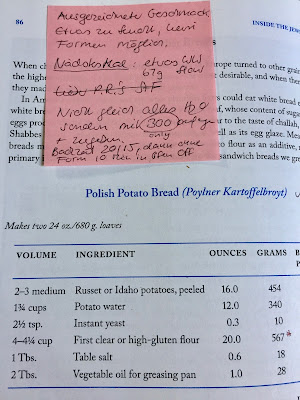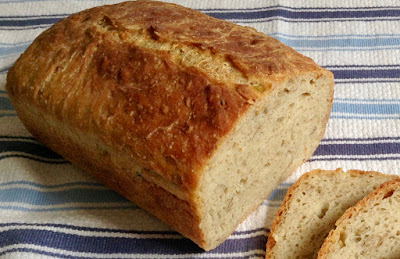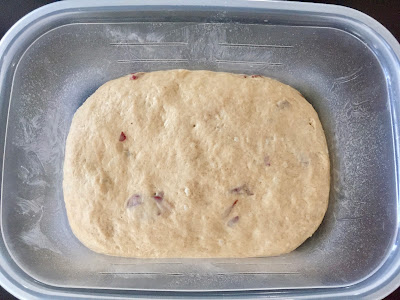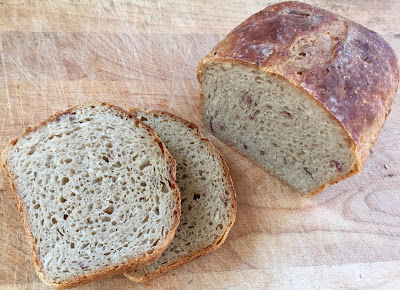
Hier geht's zur deutschen Version dieses Posts
Before my friend "The Rye Baker" Stanley Ginsberg went on his mission promoting European rye breads to American bakers, he had published another remarkable baking book: "Inside the Jewish Bakery - Recipes and Memories from the Golden Age of Jewish Baking".
I was among his test bakers. One of my test recipes was the Polish Potato Bread - Poylner Kartoffelbroyt - with its unusually high potato content an interesting recipe, but, as I soon realized, somewhat challenging in its preparation.
 |
| My first Post-It notes about the recipe |
I had problems gauging the necessary water amount, first the dough seemed too dry, then turned sticky from the potatoes.
Not only that: Stanley had warned of dire consequences if you tried taming the gooey dough with more flour - it would turn into a brick!
Somewhat intimidated, I jotted down on my note pad: "No shaping possible".
In the end, somehow, I managed to get the sticky glob into the pan. Or I wouldn't have (later) rejoiced in its "excellent taste!"
At that time I had no whatsoever experience with stickier doughs. Meanwhile, I know better how to deal with the tricky potato bread - the extra flour needs to go on the work surface, under the dough, not into it!
 |
| Potato Bread tastes especially good when toasted |
The excellent taste encouraged me to bake the Potato Bread again and again, while tweaking the recipe a little bit, especially withholding some of the water to (slowly) add it during the mixing later.
Allowing the dough to rest in the fridge overnight, I could reduce the amount of yeast a bit.
This favorite loaf really deserves to be presented at Zorra's World Bread Day 2017,
 |
| Golden brown and wonderfully moist |
POLISH POTATO BREAD (adapted from Stanley Ginsberg's: "Inside the Jewish Bakery")
227 g/8 oz Russet or Idaho potatoes, peeled or unpeeled *), cut in chunks
170 g/12 oz potato cooking water
4 g/1 tsp instant yeast
250 g/8.8 oz first clear or high-gluten flour
34 g/1.2 oz whole wheat flour
9 g/0.3 oz salt
vegetable oil, for brushing
*) I like using local red potatoes with thin skins and don't peel those
 |
| Drain cooked potatoes and reserve 170 g of the cooking water |
DAY 1
Cook potatoes in about 2 cups of unsalted water until soft, then drain, reserving 170 g/6 oz of the cooking water. Mash potatoes, and let both cool to room temperature.
 |
| Our local red potatoes don't need to be peeled |
Mix mashed potatoes, flours, yeast, and 150 g/5 oz of the reserved cooking water at low speed, until all flour is hydrated, 1-2 minutes. (Dough might seem a bit dry at first, but potatoes will add more moisture).
 | |||
| In the beginning the dough seems relatively dry... |
 |
| .... but soon becomes sticky from the potatoes |
 |
| Ready for its slumber in the fridge |
Place dough in oiled container, cover, and place overnight in the fridge. (Using a square container helps with shaping the bread later.)
 |
| Overnight the dough has doubled in volume |
DAY 2
Remove dough from refrigerator 2 hours before using. It should have doubled in volume, but will still be sticky. Grease a 9 x 5-inch/23 x 13 cm loaf pan.
 |
| The dough will still be sticky - flour your hands and bench knife! |
Transfer dough to a lightly floured work surface. With floured hands (or bench knife), pat and push it into a rough rectangle. Lift one shorter end up and fold it over a little bit, pressing gently down to seal. Continue rolling up dough in the same way into a log.
 |
| Place loaf, seam-side down, in the prepared pan |
Re-flour your hands, (or bench knife), and - this is the tricky part - lift the loaf cylinder up and place it, seam-side down, into prepared pan.
Brush top of loaf with oil, cover pan, and proof until top of dough has reached rim of pan, and a dimple, pressed with your finger, will not fill up at once (about 45 - 60 minutes).
Preheat oven to 375ºF/190ºC (no steam).
 |
| Ready to be baked |
Score loaf lengthwise (snipping with scissors works better for sticky a dough than a lamé.)
Bake bread for 20 minutes (no steaming), rotate pan 180 degrees for even browning, and continue to bake for about 20 minutes more, or until loaf is golden brown (internal temperature should be at least 195ºF/90ºC.)
 |
| Freshly baked Polish Potato Bread |
If you like your crust to stay crispier, leave bread in switched-off oven, with door slightly ajar, for an additional 10 minutes to dry. Then turn loaf out onto rack and let it cool completely.
STORAGE: The bread keeps for at least 3 days, wrapped, at room temperature. It, also, freezes well. If you slice it before freezing it, you can take out single slices for toasting.
 |
| Baked with German flour type 1050, the crumb looks a little darker |
BreadStorm users (also of the free version) can download the formula here:
This looks wonderful, Karin. Thank you for posting and sending along the tips. Wondering what kind of cheese you are showing on that sandwich, and is that cole slaw or shredded lettuce underneath the ham? I look forward to making this in next week or so. (Nancy Williams from southeast central Pennsylvania)
ReplyDeleteThanks, Nancy! I don't quite remember what cheese it was, Gouda or cheddar, but the ham was definitely Black Forest Ham. I like mayonnaise with it, so I smeared the toasted bread with Hellmann's.
DeleteIf you try the bread I'm just adding some more information to the post, since I'm baking it today.
What a beautiful loaf of bread with a great looking crust.
ReplyDeleteThank you, Karen!
Delete